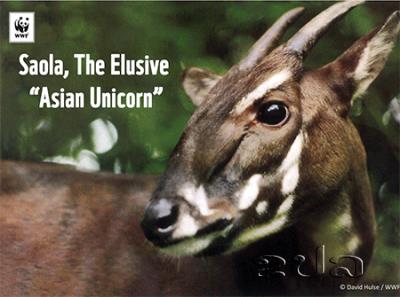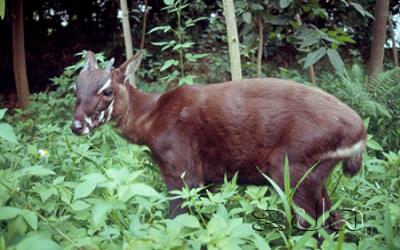KPL
(KPL) On World Saola Day, the WWF and the International Union for Conservation of Nature and Natural Resources (IUCN) Saola Working Group are calling for urgent action to save one of the world’s most endangered and rarely seen mammals -- the elusive saola, often called the “Asian Unicorn” -- which was discovered 24 years ago and lives in the dense jungles of Laos and Vietnam.

(KPL) On World Saola Day, the WWF and the International Union for Conservation of Natureand Natural Resources(IUCN) Saola Working Group are calling for urgent action to save one of the world’s most endangered and rarely seen mammals -- the elusive saola, often called the “Asian Unicorn” -- which was discovered 24 years ago and lives in the dense jungles of Laos and Vietnam.
The saola has only been recorded in the wild a handful of times by scientists since its discovery -- most recently, in November 2013, a camera trap took photos that gave renewed hope for its survival after 15 years since the last photographic evidence.
It is threatened by poaching snares and destruction of its habitat from illegal logging. The IUCN designated the saola “critically endangered” and was placed on the IUCN Red List of Threatened Species™ in 2006.
Saola experts from around the world are urging the Lao and Vietnamese governments, along with conservationists and corporations, to rally and commit to saving a species that is on the brink. WWF-Vietnam is also launching the “Save Saola” campaign in order to provide a platform to raise awareness and increase commitment from both the public and private sectors in conservation of the saola.
Numerous conservation organizations and donors, representing some of the world’s most experienced conservationists and biologists, work year round on collaborations to save the saola under the banner of the Saola Working Group, part of the Asian Wild Cattle Specialist Group of the IUCN Species Survival Commission.
“The saola symbolizes everything that’s at stake for us. If we can save it, we can save our forests, wildlife and the ecosystem services such as freshwater that the people living here depend upon. So for us, this is not just a fight to save one endangered species. It is a fight to save what it represents,” said Dr. Van Ngoc Thinh, WWF-Vietnam’s Country Director.
Descended from mammals that roamed the planet during the last Ice Age, the saola was only discovered by scientists in 1992, when a survey team from Vietnam’s Ministry of Forestry and the WWF found a skull with long and unusually graceful horns in a hunter’s home and knew immediately that it was something they had never seen before. It would later prove to be one of the most spectacular zoological finds of the 20th century: the first large mammal genus new to science in more than 50 years.
“The saola may now be the most endangered large mammal in the world. With luck, we have a small window left in which to save it – but to do so we must work urgently, creatively, and with collaboration,” said William Robichaud, Founding Coordinator of the Saola Working Group of the IUCN and Saola Programme Coordinator of Global Wildlife Conservation.
The saola resembles an antelope but is actually a member of the cattle family. The biggest threat today is poaching to supply the burgeoning demand in China and other newly affluent Asian countries for rare species – both for supposed medicinal uses and for exotic main courses at expensive restaurants. Although saola is not the target, it falls victim to the criminal gangs of poachers who seek to profit from the diverse wildlife in the Annamite Mountains. Accidentally caught in snares intended for other species, saola can be left hanging upside down until they die of starvation or thirst.

Habitat fragmentation and destruction caused by poorly planned developments and illegal logging are the other main threats. River banks cloaked in natural vegetation and mist-shrouded forests are the saola’s preferred feeding grounds, and both are being bulldozed, flooded and severed by infrastructure projects and the conversion of forest habitat into commercial crop land.
“The saola may be small in stature but its importance to conservation in Laos and Vietnam is huge,” said Mr. Somphone Bouasavanh, Country Director, WWF-Laos. “We have an opportunity and a responsibility to ensure that the saola and its forest home survive, using cutting edge science, the world’s leading conservationists and cooperation across borders.”
Amongst the early efforts to combat such threats, saola protected areas were established in 2007 in the provinces of Quang Nam and Thua Thien-Hue with support from WWF-Vietnam. Under the Carbon and Biodiversity (CarBi) Project – supported by the German Development Bank KfW -- they have since grown into a network of protected areas across the saola’s core range in Laos and Vietnam, covering more than 200,000 hectares of Annamite forests. The forest guards WWF-Vietnam recruited from local villages had by the end of 2015 removed 75,295 snare traps and dismantled 1,000 poaching operations and illegal logging camps.
Despite heroic efforts by the forest guards, the level of poaching and snaring remains high in saola habitat, threatening its future survival. If the saola is to survive in the wild, improved trans-boundary protected areas and increasing collaboration between Vietnam and Laos are urgently needed to protect the remaining intact forest and prevent poaching. In addition, demand reduction programmes for wild meat and medicinal needs, especially in Vietnam, could reduce the poaching pressure that leads to saola deaths.
One solution being discussed by the Saola Working Group of the IUCN Species Survival Commission and the Governments of Lao PDR and Vietnam is a captive breeding programme. The goal is to provide an “insurance” population for re-introduction should the saola become extinct in the wild. World-renowned experts in captive breeding and the care of species like saola would be recruited to ensure the captured saola have the best chance to survive and breed.
KPL